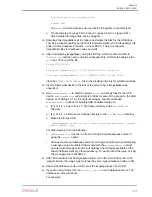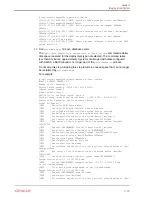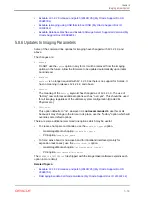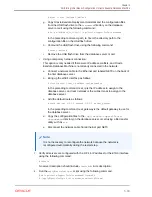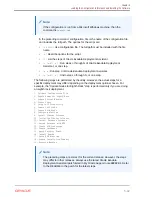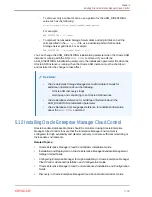
Note:
If the configuration is run from a Microsoft Windows machine, then the
command is
install.cmd
.
In the preceding command, configuration_file is the name of the configuration file,
and includes the full path. The options for the script are:
•
-cf file
: Use configuration file. The full path must be included with the file
name.
•
-h
: Describe options for the script.
•
-l
: List the steps of Oracle Exadata Deployment Assistant.
•
-r {n-N | n }
: Run steps n through N of Oracle Exadata Deployment
Assistant, or one step.
•
-s n
: Run step n of Oracle Exadata Deployment Assistant.
•
-u {n-N | n }
: Undo steps n through N, or one step.
The following steps are performed by the utility. However, the actual steps for a
specific deployment may differ depending on the deployment options chosen. For
example, the "Update Nodes for Eighth Rack" step is performed only if you are doing
an eighth rack deployment.
1. Validate Configuration File
2. Update Nodes for Eighth Rack
3. Create Virtual Machine
4. Create Users
5. Setup Cell Connectivity
6. Create Cell Disks
7. Create Grid Disks
8. Configure Alerting
9. Install Cluster Software
10. Initialize Cluster Software
11. Install Database Software
12. Relink Database with RDS
13. Create ASM Diskgroups
14. Create Databases
15. Apply Security Fixes
16. Install Exachk
17. Setup ASR Alerting
18. Create Installation Summary
19. Resecure Machine
Note:
The preceding steps are correct for the current release. However, the steps
may differ for other releases. Always use the latest Oracle Exadata
Deployment Assistant patch listed in My Oracle Support note 888828.1. Refer
to the README in the patch for the latest steps.
Chapter 5
Loading the Configuration Information and Installing the Software
5-92




